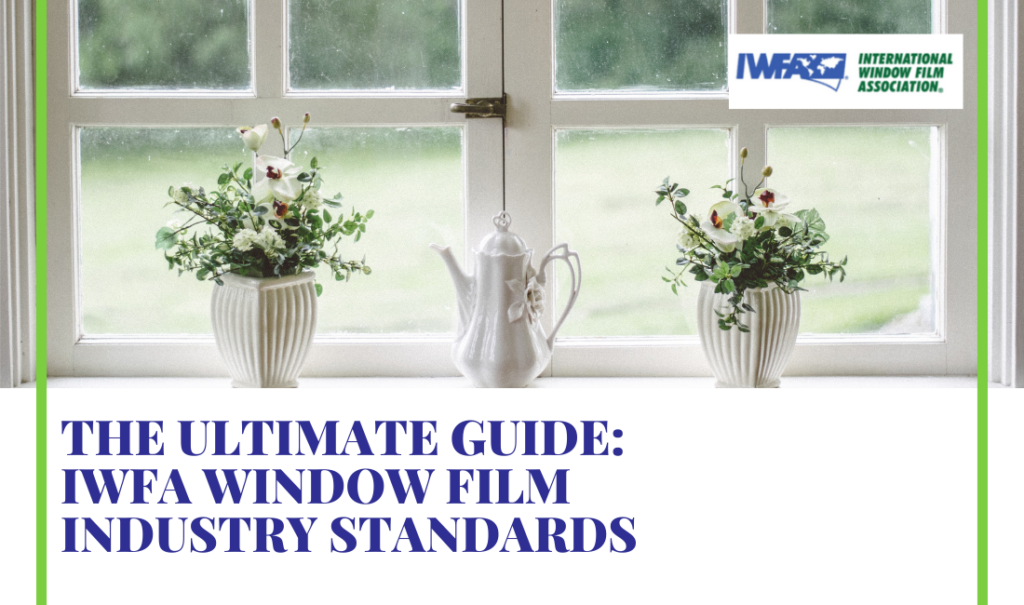The Ultimate Guide: IWFA Window Film Industry Standards
The International Window Film Association, or the IWFA, provides guidelines and standards to ensure that window film installations are safe, effective, and high-quality. In this guide, we review their guidelines which cover installation techniques, product performance criteria, and safety and durability standards. Adhering to these guidelines and standards helps to ensure consistent and safe installations. And, makes products meet high-quality performance criteria.
The IWFA’s main focus is on safety and durability. This helps to ensure that window films are safe and reliable for a wide-range of uses. Overall, the IWFA is essential to advancing the window film industry and providing effective solutions for consumers.


The International Window Film Associations, or IWFA, provides guidelines and standards to ensure that window film installations are safe, effective, and high-quality.
In this guide, we review their guidelines which cover installation techniques, product performance criteria, and safety and durability standards. Adhering to these guidelines and standards helps to ensure consistent and safe installations, as well as high-quality window film products that meet specific performance criteria.
The IWFA’s main focus is on safety and durability. This helps to ensure that window films are safe and reliable for a wide-range of uses. Overall, the IWFA is essential to advancing the window film industry and providing effective solutions for consumers.

Who is the IWFA?
The International Window Film Association (IWFA) is a non-profit organization that serves as the leading resource for the window film industry. Since 1991, the IWFA has been dedicated to advancing the use of window film. They work to ensure professional installers use proper techniques.
The organization provides various resources, including industry research, educational programs, and advocacy efforts. IWFA’s primary function is to establish guidelines and standards for the window film industry. In the next section, we will cover these guidelines.
IWFA Guidelines for Installation
The IWFA has established guidelines for window film installation. Their aim is to ensure that all installations are performed safely and effectively. These guidelines cover various topics, including surface preparation, film application, and post-installation cleaning. Some of the key requirements outlined in the IWFA guidelines include:
Surface Preparation
Before applying window film, it is important to ensure the surface is clean and debris-free. IWFA recommends using a cleaning solution free of ammonia or other abrasive chemicals. Additionally, the surface should be dry before the film is applied.
Film Application
Using the proper installation technique is crucial when adding window film. If not properly installed, window film can have issues with adhering which can cause wrinkles or bubbles. The IWFA guidelines recommend using a squeegee to smooth out the film, starting from the center and working outward. Additionally, installers should avoid applying excessive pressure, as this can cause the film to stretch or tear.
Post-Installation Cleaning
After the film has been applied, it is important to clean the surface to remove any adhesive residue or other debris. IWFA recommends using a mild cleaning solution and a soft cloth or sponge. Abrasive materials can damage window film.
IWFA Product Performance Standards
In addition to guidelines for installation, the IWFA has also established standards for product performance. These standards aim to ensure that window film products are of the highest quality and meet specific performance criteria.
The IWFA requires window film manufacturers to meet the standards in order to earn IWFA certification. These standards cover a range of performance criteria, including solar heat gain reduction, visible light transmission, and UV protection.
Solar Heat Gain
Solar heat gain reduction is a key performance factor for window films. It determines how effectively the film blocks solar radiation and reduces heat transfer through the window. The IWFA standards require that window films achieve a minimum of 35% solar heat gain reduction to earn certification.
Visible Light Transmission
Visible light transmission is another important factor. It determines how much natural light is able to pass through the window. The IWFA standards require that window films allow at least 15% visible light transmission to earn certification. This ensures the film does not significantly darken the interior of the building.
UV Protection
UV protection is also a critical factor for window films, as it helps to protect occupants from harmful UV radiation. The IWFA standards require that window films block at least 99% of UV radiation to earn certification. This provides high UV protection for building occupants.
Read more about UV radiation in our post, Window Films Save Energy, and Keep You Comfortable.
IWFA Safety and Durability Standards
IWFA has established safety and durability standards for certification that window films must meet. These standards ensure that window films are safe and reliable for various environments and applications.
Safety Standards
One important safety standard is the flammability test, which assesses the film’s resistance to ignition and flame spread. The IWFA requires that certified window films meet certain flammability standards to ensure that they do not pose a fire hazard.
Another safety consideration is the film’s impact resistance. This is extremely important for applications where the window may be at risk of being struck by objects such as hailstones or baseballs. The IWFA requires certified films to meet certain impact resistance standards to ensure they do not shatter or break in these situations.
Durability Standards
Durability is also a key consideration for window films. The films must be able to withstand exposure to a variety of environmental factors without degrading or losing their effectiveness. The IWFA requires that certified films meet certain standards for durability, including resistance to fading, discoloration, and peeling.
One important durability test is the weathering test. It assesses the film’s ability to withstand exposure to sunlight, temperature changes, and other environmental factors over an extended period of time. The IWFA requires that certified films meet certain weathering standards to ensure that they remain effective and reliable for many years.
By establishing standards, the IWFA helps ensure that certified window films are safe and effective for use in various applications. Installers and consumers can be confident that certified films have been rigorously tested and shown to meet the highest safety, durability, and performance standards.
Summary
The IWFA guidelines and standards are essential for ensuring that window film installations are safe, effective, and of the highest quality. From guidelines for installation to standards for product performance, the IWFA provides a comprehensive framework for the window film industry.
By adhering to these guidelines and standards, installers can help to ensure that window film installations are performed consistently and safely. And, consumers can have confidence in the durability and effectiveness of their window film products.
Furthermore, the IWFA’s focus on safety and durability helps to ensure that window films are safe and reliable for use in a wide range of environments and applications. Whether you are installing window film in your home, office, or commercial building, adhering to IWFA guidelines and standards can provide peace of mind and ensure a high-quality installation.
In summary, the IWFA is an essential resource for the window film industry. It provides guidance and standards for ensuring safety, effectiveness, and durability. By following these guidelines and standards, the window film industry can continue to advance and provide effective solutions for various needs.
IWFA Guidelines FAQs
The IWFA guidelines cover surface preparation, film application, and post-installation cleaning. They recommend using a non-abrasive cleaning solution, ensuring the surface is completely dry before application, using a squeegee to smooth out the film from the center outward, and avoiding excessive pressure during installation.
The IWFA sets standards for solar heat gain reduction (minimum 35%), visible light transmission (at least 15%), and UV protection (blocking at least 99% of UV radiation). These standards ensure that certified window films meet specific performance criteria.
Professional installation ensures durability, prevents window damage, provides maintenance guidance, and offers tailored recommendations. Experts have the knowledge and tools to apply the film seamlessly, minimize risks associated with DIY installations, and advise on the best products for specific needs.
UHS Window Tinting & Blinds provides a standard lifetime warranty for their residential window film applications, demonstrating their confidence in the quality of their products and services.

Read how 3M™ Sun Control Window Film Prestige Series creates smarter windows for a more comfortable home.
Know someone who can benefit from window tinting?
Share with your friends!
